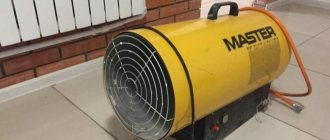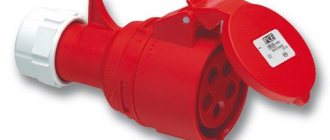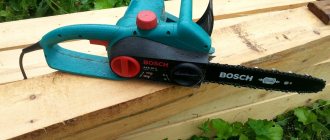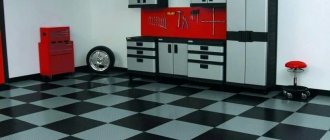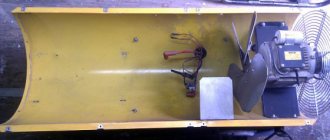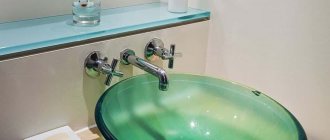Despite all their advantages, conventional oil heaters and convectors are simply not able to quickly warm the air to the required temperature in large rooms. Heat guns cope well with this task. Today there are a wide variety of models on the market. They are widely used for heating warehouses, industrial premises, greenhouses and other large areas. They are also indispensable on open construction sites for creating and maintaining a comfortable temperature in the work area.
Heat gun: what is this unit?
This is a powerful device that allows you to warm the air in a room to a given temperature in a matter of minutes, distributing it evenly over the entire area. This device is very popular today, because it can be installed in almost any room and outdoor area. It can serve as a source of heating areas during the cold season in the absence of other types of heating.
Heat gun device
The principle of operation of a heat gun is to generate a hot stream of air, which, with the help of a powerful fan, is driven towards the heating element. Passing through it, the air warms up, and then the heat flow is evenly distributed throughout the room. Most models of these devices look like a pipe, which is how this device got its name.
Heat guns are equipped with a durable metal casing designed to protect them from any damage, and the heating element is completely fireproof. Almost all of them are mobile and do not weigh too much, which allows you to effortlessly move the device to another place.
Types of heat guns
All existing heat guns can be divided into several groups depending on the fuel consumed or electricity used. The most common types of these devices are:
- diesel;
- gas;
- electric.
Types of heat guns
In turn, those operating on liquid fuel, and in particular diesel ones, can be either directly heated or indirectly, when combustion products are removed from the room. To operate gas heat guns, both main gas and cylinders can be used. Most often, these 2 types of devices are used to heat the premises of buildings under construction or where there is no access to electrical networks. When these devices operate, oxygen is burned, as a result of which their use is more relevant outdoors or indoors where there is supply ventilation.
Heat guns powered by electricity are practically free of such disadvantages as burning oxygen while heating the air. Therefore, they are more often used in residential, retail, office or other similar premises.
Which manufacturer should you prefer?
In domestic stores of heating equipment, electric guns can be found both imported and manufactured in Russia. In general, there is not much difference between them. Here you need to focus more on the power of the device.
But among the manufacturers there are also recognized leaders, for whose branded fan heaters you will have to overpay a little.
If you need a powerful and durable electric heating gun, then you should pay special attention to models under the brands Ballu (Netherlands) and Master (USA)
Fan heaters are produced by a fairly large number of domestic and foreign companies.
Among the main brands that have won the trust of consumers are:
- Ballu (a Dutch brand, but production is established in Russia);
- Master (USA);
- Timberk (Sweden);
- Inforce (Russia);
- Fubag (Germany);
- Quattro (Italy);
- Tropic (Russia);
- Resanta (Latvia).
Almost all manufacturers offer heat guns in a wide range of heating power and air flow. In the existing range of this equipment, there is always a model for specific needs, you just need to correctly assess the needs.
Taking an electric gun that is too powerful and then turning it off every few minutes so as not to burn yourself is not very smart and costly.
If you want to save money, you can make an electric gun yourself. For assembly you will need a heating element, housing material (metal sheet or pipe), a fan and a motor.
Which heating gun is better to choose?
When choosing a heat gun to heat a certain room, as when purchasing any other equipment, you should always correlate your needs with the available capabilities. First of all, you need to decide what exactly this device is needed for - for permanent or temporary use, for regular heating of the room or for using the device only for periods.
Heat gun design
In addition to these factors, you will need to consider:
- the size of the room in which the air will need to be heated;
- availability of a particular energy source;
- the presence of ventilation in the room and the possibility of removing combustion products from it;
- permanent or temporary presence of people.
Advice. When choosing the required power of a heat gun, you can base your calculations on approximately the following: 0.8-1.4 kW per 10 sq.m.
To make it easier to understand the most suitable type of device, it is worth taking a closer look at each of the 3 types of guns, assessing the pros and cons of electric, diesel and gas equipment.
No. 8. Other technical characteristics
To assess whether this or that equipment is suitable for you, you need to analyze a number of additional parameters:
- air flow value, m3/hour. The indicator indicates how well the fan works. Ideally, it should be powerful enough to quickly warm the air around it and prevent overheating of the air directly around the gun. The amount of air flow is the volume of warm air that the device can generate in 1 hour of operation. The higher the power of the gun, the greater the air flow. The indicator ranges from 100-150 to 800 or more m3/hour;
- length of the air stream, m. This indicator also depends on the power of the fan and makes it clear how far the device can send an air stream;
- fuel consumption, kg/h or l/h helps to evaluate the efficiency of the device. It makes sense to compare the parameter with the same power of samples;
- operation noise, dB. All guns that operate thanks to a fan are noisy. The higher the power, the higher the noise level. If compact electric guns produce only 40-50 dB, then large gas and diesel ones can produce 80-90 dB, which will be disturbing in a small room. If noise level is a critical indicator, then it is better to leave the choice on the infrared model;
- duration of work. If the gun is the only source of heat, then it is important that it can work almost around the clock. In the model description you can see something like this 24/1 or 24/2. This means that the device can rest for 1-2 hours per day.
Diesel fuel heat guns
The design of diesel units is quite simple. These devices consist of:
- fan;
- burners;
- combustion chambers;
- fuel tank.
Diesel fuel heat gun
These are the main parts of the device; many models are equipped with wheels for moving the device. Fuel is supplied using a compressor or pump. Heat flow is created when an electric fan operates. They can work autonomously, for which the devices contain a thermostat, timer, and flame control system. They come in different capacities. No permission is required to install them.
In devices with a direct heating type, all combustion products are discharged immediately into the surrounding air. Because of this, they are not suitable for heating rooms where people live. Units with indirect heating are less powerful, but much safer to operate. They have a special tube, with the help of which combustion products are removed from the room by connecting to the chimney. Such devices can already sometimes be used in rooms where people are located, if there is ventilation or regular ventilation there. But due to the high noise level during operation of the device, its use in residential, commercial or office areas is not very frequent.
Direct heating diesel fuel heat gun
The main purpose of diesel units is to heat rooms such as:
- production workshops;
- industrial areas;
- construction projects;
- warehouses;
- open areas;
- premises for agricultural purposes.
In addition, diesel guns are often used for drying and defrosting various materials, as well as to speed up the drying process of treated indoor surfaces during repair work.
No. 7. Thermal power and its calculation
How to compare several different devices in terms of performance? How do you understand that one device is designed to heat small garages, while another can easily warm up a huge warehouse? You need to look at the power indicator, and we are not talking about the electrical power consumed, or rather not always about it. This parameter will be indicative only for electric models. So let's start with them.
The power of electric guns ranges from 1 to 50 kW. It’s difficult to call 1-3 kW models “guns” - they’re more like fan heaters. Let us repeat that devices with a power of up to 5 kW can be connected to a 220 V network. Anything larger is equipment that requires a 380 V network. The most powerful electric guns are devices up to 100 kW.
The power of gas appliances ranges from 10 to 150 kW, but more powerful devices are often found. Diesel and multi-fuel direct heating devices produce all 220 kW, but their indirect heating counterparts have less power - a maximum of 100 kW. Infrared guns are rarely more powerful than 50 kW.
How do you know how much power is needed? Many people advise using an approximate calculation method, according to which 1-1.3 kW of power is sufficient for 1 m2 of space. If the room is low and well insulated, you can multiply by 1 kW, and if there are problems with thermal insulation, then it is better to take the coefficient with a margin.
If you want to get a more accurate result, then arm yourself with a calculator and the following calculation procedure:
- calculate the volume of the room , since this parameter is much more important than the area parameter. If you take a room with an area of 90 m2 and imagine that the ceiling height in it is 4 m, then the volume will be 360 m3;
- temperature difference between the desired indicator indoors (for example, +180C) and the indicator outside the walls. The weather outside in winter can be different. It is usually recommended to take into account the average winter temperature, making allowances for possible frosts. If the gun is the main source of heat, then it is better to take into account the lowest winter temperature. If you are making calculations for a residential building, then choose the comfortable internal temperature yourself. For warehouses, the accepted temperature is +120C, for public buildings - +180C. So, let’s say that in winter there are often frosts down to -200C outside, but inside you need to maintain the temperature at +180C, then the difference will be 380C;
- thermal insulation of the room plays an important role. A special coefficient is taken into account when calculating the power of the gun. If all walls, floor and roof are insulated, the number of windows is small, they have double frames, then k = 0.6-1. If the walls are brick, but without insulation, the roof is standard, and the number of windows is average, then k = 1-2. For structures with a single brick wall and single window frames (garages, for example), the coefficient k = 2-3 is used. For open and semi-open areas, simplified wooden and metal structures without thermal insulation, k = 3-4. Let's say we have a garage with double brick walls without thermal insulation, into which visitors will more or less often enter, then we will assume that k = 1.8;
- Thermal power is calculated using the formula Q = k*V*T. Then we get Q = 1.8*360*38 = 24,624 kcal/h, and since there are 860 kcal/h in 1 kW, it turns out that Q = 24624/860 = 28.6 kW;
- if the gun is not the only source of heat in the room, then this must be taken into account and the power of the existing equipment must be subtracted from the final result;
- You can take more than one high-power gun, but several smaller ones, in order to ultimately obtain the necessary power. If the room has a complex configuration, then several less powerful guns are even better than one more powerful one.
Gas heat guns
Heat guns using gas can be called the most economical and productive. Like diesel engines, they are most often used in non-residential premises: construction sites, pavilions, workshops, production facilities, greenhouses. But they are also used for heating residential premises if they have forced ventilation, as well as for drying surfaces after finishing work during repairs.
Attention! Gas-powered guns are not used to heat basements or rooms where animals are kept.
Propane or butane is used as fuel in such units. They can be connected to the main gas pipeline, which significantly reduces the cost of heating the room, or run from liquefied gas cylinders. Many models of these devices, when replacing some parts, can be connected in one way or another, depending on access to the line in each specific case. When a gas heat gun operates, no smoke or odor is emitted. Models of varying power are produced, many of which are capable of effectively heating fairly large areas. All of them are quite simple both in maintenance and transportation.
Gas heat gun
The distinctive features of these guns compared to other types include:
- fairly high performance;
- almost complete combustion of fuel;
- the distribution of heat flow throughout the room is most uniform;
- the electricity consumption required to operate the fan is minimal;
- mandatory presence of a thermostat;
- Possibility of use in crowded places.
Heat guns powered by electricity
Units powered by electricity can serve as a source of both additional heating of areas and the main one. During their operation, oxygen is practically not burned, as a result of which they are often used in enclosed spaces, including offices and residential ones - in apartments and country houses.
Electric heat gun
They are compact in size, not too heavy, and are quite easy to carry from one place to another. Their power range is high and can be used to heat rooms of various sizes, even quite large areas. But if you compare them with gas or diesel counterparts, they are significantly less powerful, but they are easy to use and do not require fuel. To warm up the room to a comfortable temperature within just a few minutes, you just need to plug the unit into an electrical outlet.
The advantages of electric heat guns are:
- safety, reliability and durability;
- compactness, since there is no fuel tank and combustion chamber;
- mobility in moving the device;
- noiselessness during operation;
- no need for fuel;
- possibility of operation from the network or generator;
- no additional maintenance.
Advice. Despite the fact that the electric gun burns almost no oxygen in the room, it is still desirable to have ventilation in it. If there is no supply ventilation, it is necessary to regularly ventilate the room.
Among some of the disadvantages of these devices, only 2 can be identified:
- constant access to electrical networks for operation of the device;
- the cost of electricity is quite high, which leads to a significant increase in the cost of heating the room.
Electric heat guns are the lightest and safest.
When choosing a heat gun suitable for heating a particular room, you will need to evaluate various factors. All of them are quite important, so you need to carefully consider them before purchasing the device. The correct choice of device will help to effectively warm the air in the room in the shortest possible time and at a reasonable cost, making it comfortable for being there.
What are the disadvantages of electric heat guns?
The disadvantages of electric heat guns are related to their power source - electricity. The heat gun is connected to the electrical network. In facilities where it is not possible to connect to the network, this type of heating will not work. Moreover, if low- and medium-power guns operate from a 220 V household network, then high-power models designed to serve large areas mostly operate from a 380 V network. And if you plan to use the equipment as a constant source of heat, be prepared to a noticeable increase in electricity bills.
